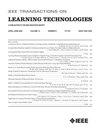增强美感的绘本路径强化学习驱动优化
IF 4.9
3区 教育学
Q2 COMPUTER SCIENCE, INTERDISCIPLINARY APPLICATIONS
引用次数: 0
摘要
审美能力作为艺术教育的核心能力,培养学生的文化敏感性、情感表达能力和批判性思维能力。然而,现有的审美知觉培养方法往往缺乏系统的指导和个性化的发展途径,限制了它们支持持续和个性化增长的能力。两个核心挑战仍未解决:第一,如何有效地模拟学生审美理解的动态、多维进展;第二,如何构建连贯的学习路径,引导学生从基本的感性意识到更抽象的艺术参与。为了解决这些问题,我们提出了基于强化学习的推荐模型AesthPath,该模型构建了个性化的绘本学习路径来增强审美。具体来说,该模型引入了一个马尔可夫决策过程公式,该公式捕捉了学习者审美能力在多个维度上的演变状态。然后,基于持续的学习者反馈,通过平衡新内容的探索和有效材料的强化,采用演员-评论家算法来生成自适应学习轨迹。与传统的静态或基于规则的推荐方法不同,AesthPath支持细粒度、反馈驱动的学习轨迹优化,促进目标导向和个性化的审美感知发展。在真实数据集上的实验结果证明了AesthPath在提高学生审美理解方面的有效性。本研究为智能学习路径设计和教育建议提供了新的理论和方法见解,突出了强化学习在自适应学习场景中的潜力。本文章由计算机程序翻译,如有差异,请以英文原文为准。
Reinforcement Learning-Driven Optimization of Picture Book Paths for Aesthetic Perception Enhancement
Aesthetic perception, as a core competence in art education, fosters students’ cultural sensibility, emotional expression, and critical thinking. However, existing approaches to cultivating aesthetic perception often lack systematic guidance and personalized developmental pathways, limiting their capacity to support sustained and individualized growth. Two central challenges remain unresolved: first, how to effectively model the dynamic, multidimensional progression of students’ aesthetic understanding, and second, how to construct coherent learning paths that guide students from basic perceptual awareness to more abstract artistic engagement. To address these issues, we propose AesthPath a reinforcement learning-based recommendation model that constructs personalized picture book learning paths to enhance aesthetic perception. Specifically, the model introduces a Markov decision process formulation that captures the evolving states of learners’ aesthetic competence across multiple dimensions. An actor–critic algorithm is then employed to generate adaptive learning trajectories by balancing exploration of new content with the reinforcement of effective materials, based on ongoing learner feedback. Unlike traditional static or rule-based recommendation methods, AesthPath supports fine-grained, feedback-driven optimization of learning trajectories, facilitating goal-oriented and personalized development of aesthetic perception. Experimental results on a real-world dataset demonstrate the effectiveness of AesthPath in enhancing students’ aesthetic understanding. This study offers new theoretical and methodological insights for intelligent learning path design and educational recommendations, highlighting the potential of reinforcement learning in adaptive learning scenarios.
求助全文
通过发布文献求助,成功后即可免费获取论文全文。
去求助
来源期刊

IEEE Transactions on Learning Technologies
COMPUTER SCIENCE, INTERDISCIPLINARY APPLICATIONS-
CiteScore
7.50
自引率
5.40%
发文量
82
审稿时长
>12 weeks
期刊介绍:
The IEEE Transactions on Learning Technologies covers all advances in learning technologies and their applications, including but not limited to the following topics: innovative online learning systems; intelligent tutors; educational games; simulation systems for education and training; collaborative learning tools; learning with mobile devices; wearable devices and interfaces for learning; personalized and adaptive learning systems; tools for formative and summative assessment; tools for learning analytics and educational data mining; ontologies for learning systems; standards and web services that support learning; authoring tools for learning materials; computer support for peer tutoring; learning via computer-mediated inquiry, field, and lab work; social learning techniques; social networks and infrastructures for learning and knowledge sharing; and creation and management of learning objects.
 求助内容:
求助内容: 应助结果提醒方式:
应助结果提醒方式:


